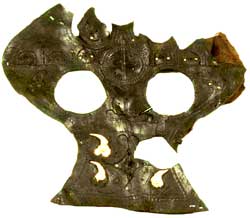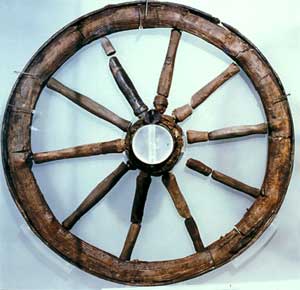
Click on the image for a larger version.
|
Image
details:
A reconstruction of the leather tent that
housed eight men of the contubernium, made from goatskins.
Image ownership:
© Mike Bishop, ARMAMENTARIVM |
Most units of the Roman army possessed a wide range of craft and
artisan skills. A late Roman list of legionary immunes (soldiers
exempted from general duties because of their specialist skills)
includes 'ditch diggers, farriers, master builders, pilots, shipwrights,
ballista makers, glaziers, smiths, arrow makers, coppersmiths, helmet
makers, wagon makers, roof-tile makers, swordcutlers, water engineers,
trumpet makers, horn makers, bow makers, plumbers, blacksmiths,
masons, limeburners, woodcutters, charcoal burners, butchers, huntsmen,
keepers of sacrificial animals, … grooms and tanners…'
(Tarrentenus Paternus, Digest, 50, 6, 7, Trans, Bowman).
The range of specialisms and the scale of production were greatest
in the legionary fortresses. Nevertheless the expertise possessed
by the auxiliary garrisons made it possible to achieve a high degree
of self-sufficiency. The tablets and the archaeological evidence
give an insight into many of the skills possessed.
References to supplies of iron and lead (155,
182) and to smiths (160)
and the spreads of slag, ash and charcoal and instances of broken
crucibles in the phase V building provide clear evidence of metal-working
at Vindolanda. Among the items being manufactured were weapons.
As well as smiths, 160 also mentions
shieldmakers (scutarii) and possibly swordsmiths (gladiarii).
Legionary workshops perhaps produced much of the army's weaponry,
but the evidence of Vindolanda shows that auxiliary units also played
an important part in arms making.

Click on the image for a larger version.
|
Image
details:
An almost complete horse chamfron (cover
worn over the front of the horse's head), retaining some of
the brass studs and plaques with which it was originally decorated
Image ownership:
© Vindolanda Trust |
One of the working parties recorded in 155
comprised the sutores - leatherworkers or cobblers. Leather,
both cattle hides and goatskins, was required for tents, horse-gear,
clothing, bags and shields. The requirement of 70 goatskins per
tent (the smallest auxiliary unit needed 48 tents), illustrates
the scale of demand. The presence of scrapers and combs, to one
of which animal hair still adhered, also indicates the processing
of hides. The several thousand leather items from Vindolanda comprise
one of the largest assemblages from the Roman world. Among the recognisable
items, shoes, tentage and horse gear dominate, although there is
a wide variety of individual pieces including sheaths and purses.
The leather finds are amongst the most impressive of the surviving
artefacts, for example the decorated horse chamfron from the period
3 praetorium. Offcuts from new leather and evidence for
salvaging leather from worn-out items both testify to leather-working.
A graffito on one of these reveals a name known from a tablet, Veldedeius,
the governor's groom, for whom it had perhaps been ordered (310).

Click on the image for a larger version. |
Image
details:
A wooden wagon wheel from Newstead, southern
Scotland. The wheel, c. 0.9m in diameter from a waterlogged
deposit of the first century AD, has a hub of elm protected
by an iron ring, spokes of willow and an ash rim.
Image ownership:
© The Trustees of the National
Museums of Scotland |
The assembly or repair of vehicles at Vindolanda provides evidence
of skilled woodworking. A letter (309)
records the dispatch of numerous vehicle components, including hubs
(modiola), axles (axes), spokes (radia) and
seats (sessiones). Parts of vehicles rarely survive, although
exceptionally wheels were recovered from wells in a Roman fort in
the Scottish Borders at Newstead. From artistic
representations and chariot burials from other provinces, where
the metal fittings survive, reconstructions of the form of carts
and wagons can be suggested.
Soldiers were farmers as well as artisans. Many units produced
at least some of their own food. Oxherds (bubulcarii, ad iuvencos)
(180), swineherds (…. ad porcos)
(183) and brewers (cervesarii)
(182) are all mentioned in the tablets,
although not all of these individuals need be soldiers. Around the
fort are likely to have been the paddocks in which animals grazed.
Tablet database link: Browse all tablets related to work and manufacture.
|